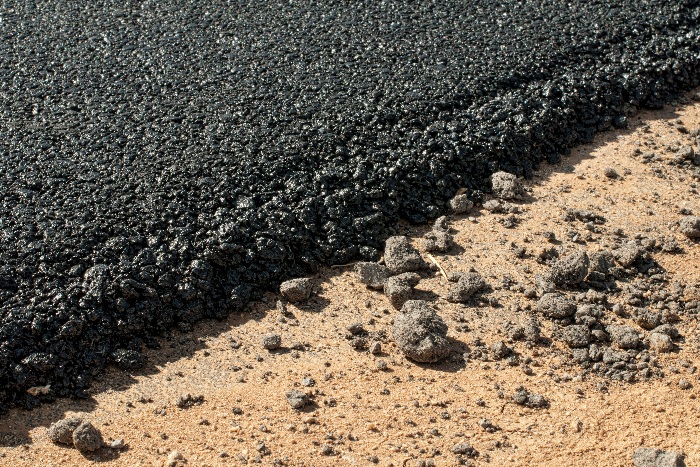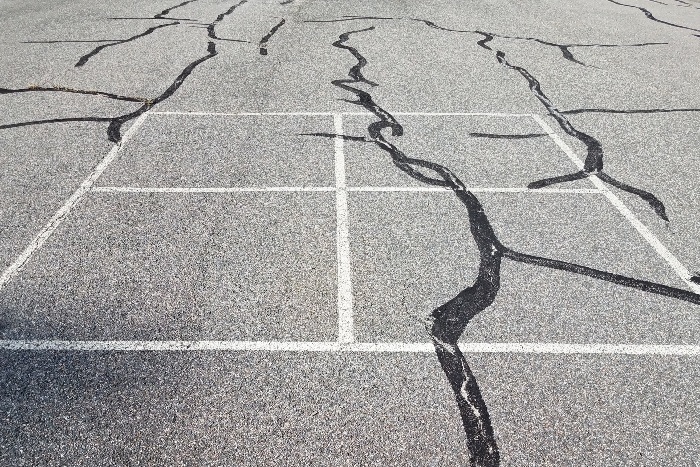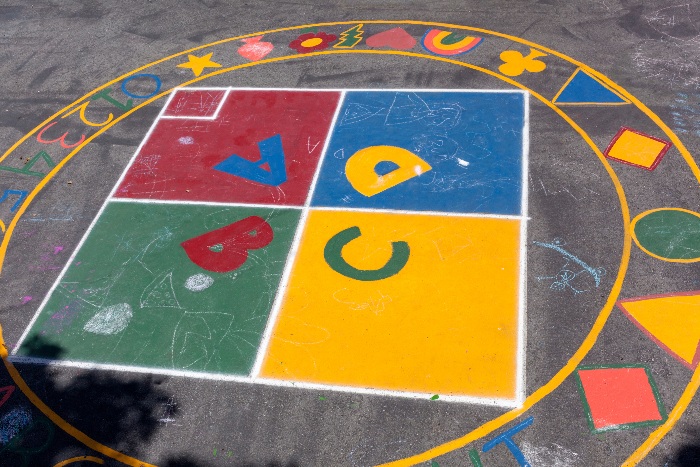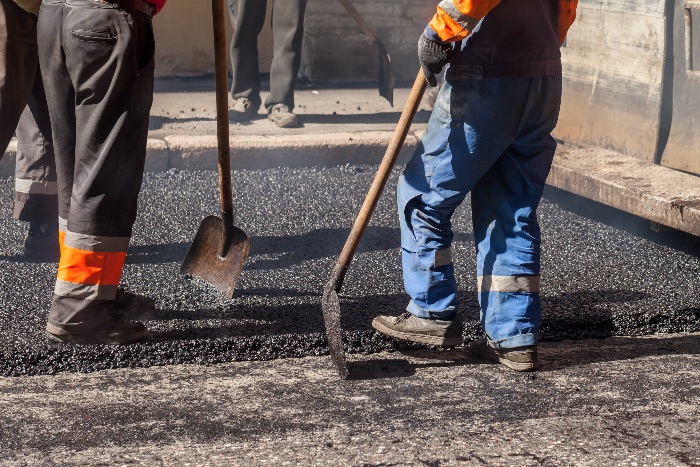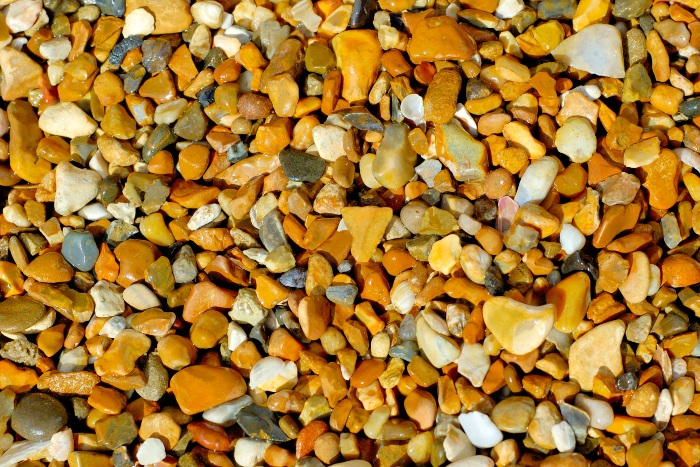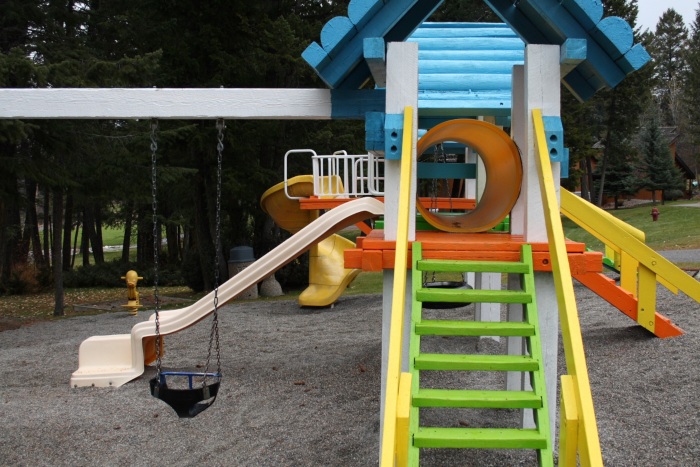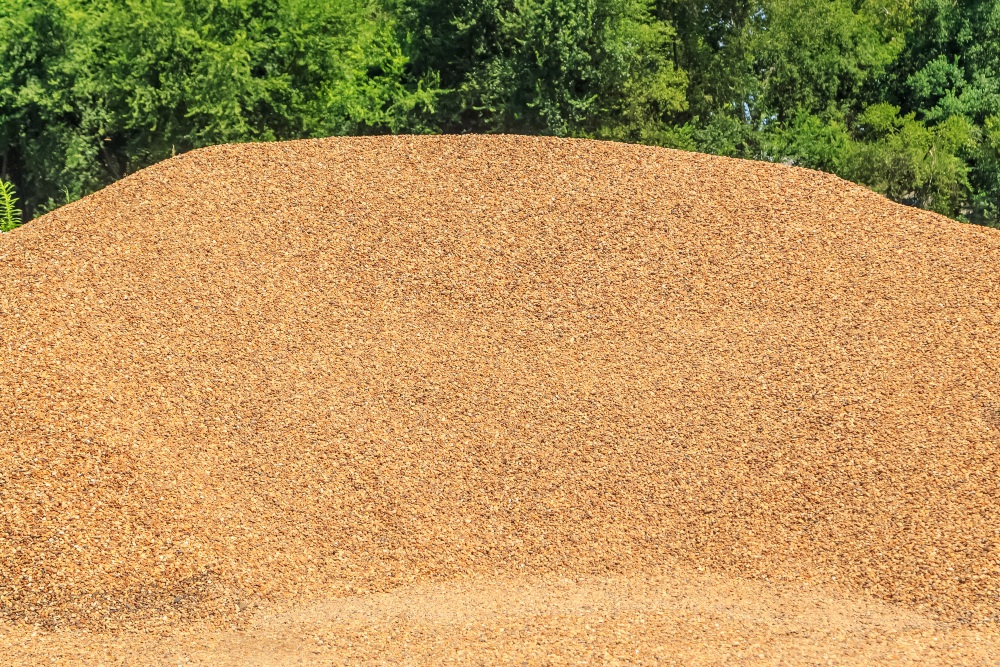The world of playground surfacing options can be vast and complex. You want playground surfacing that does it all: meets safety requirements, fits your budget, and requires low maintenance. Plus, your playground project has its own unique needs and priorities. The question remains: what flooring material is suitable for your playground project? We’ve created an ultimate guide of all the pros and cons of 11 of the most popular playground surfaces.
- Pavement
- Pea Gravel
- Sand
- Natural Grass and Soil
- Artificial Grass
- Bonded Rubber Mulch
- Rubber Mulch
- Engineered Wood Fiber (EWF)
- Wood Chips
- Poured Rubber Surfacing
- Rubber Tiles
1. Pavement
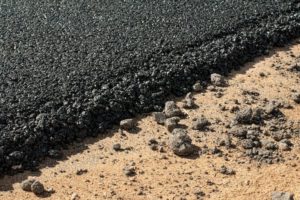
Pros: The best part about concrete and asphalt pavement surfaces are that they are American Disabilities Act (ADA) compliant for ramps and flooring. It is cheaper than other surfacing options and can last 30-50 years without being entirely replaced. While you can DIY a pavement surface installation, it’s best to leave this project to the professionals.
Cons: A significant factor in hard pavement surfaces is the complete lack of shock absorbency, which doesn’t meet American Standard Testing Methods (ASTM) guidelines for fall height. Extra details and stains add to its cost, but pavement can get expensive to repair. Expect costly and complicated repairs of frequent cracks and splits caused by fluctuations in temperatures.
2. Pea Gravel
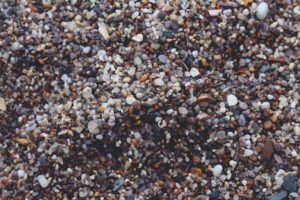
Pros: At depths of nine inches, pea gravel can sufficiently reduce the impact of a fall from playground equipment and meets ASTM standards for impact attenuation. This relatively low-cost loose-fill material is easy to install by yourself and relatively easy to rake stones back into place.
Cons: Unfortunately, pea gravel only protects falls from up to five feet. Plus, it doesn’t meet ADA safety standards due to its constant shifting underfoot. Did we mention pea gravel is high maintenance, requiring endless raking as kids play on the surface? You will need to replace this non-shock absorbing surface almost every few years as it breaks down into stone dust.
3. Sand
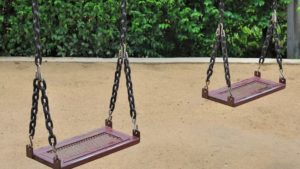
Pros: Decades of use in playgrounds designate sand as an appropriate playground surface by ASTM when spread 9 inches deep for a fall height of 4 feet. Sand is one of the cheapest playground surfacing options out there, and it’s easy to find and install. Better yet, it doesn’t support microbial growth. Be sure to buy sand graded for use in playgrounds as it’s rounded to smooth out any large, sharp particles.
Cons: Despite its ubiquity in playgrounds, sand has limited impact absorption and compacts to create an unsafe solid surface over time. Sand doesn’t meet ADA accessibility standards. It’s challenging for wheelchairs or disabled folks to navigate. Let’s not forget about the likelihood of finding animal waste, insects, or weeds in the sand, or, even worse, asbestos and silica in the sand. Not only do you need more sand to achieve a 12-inch depth for a six-foot fall zone, but you also need to replace 25% every year and commit to weekly rankings to keep it safe.
4. Natural Grass and Soil
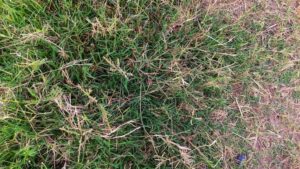
Pros: Using natural grass and soil for a playground surface can be aesthetically pleasing and bring natural benefits. The low temperature of natural grass reduces heat island effects. Its root system filters out harmful pollutants before they enter local groundwater systems. Natural grass is also cheap to repair or fill in bare spots.
Cons: The downside to grass? It won’t be green for long. It quickly wears, especially in extreme weather, creating unsafe muddy or uneven bare spots. Speaking of risk, the Consumer Product Safety Commission (CPSC) and ASTM report natural grass and dirt as an inappropriate surfacing for playgrounds. In addition, its high-friction surface makes it difficult for wheelchairs to navigate. While inexpensive to install, the cost of natural grass maintenance can quickly add up. It requires expensive irrigation systems and daily maintenance like blowing leaves, mowing, fertilizing, weeding, and more.
5. Artificial Grass
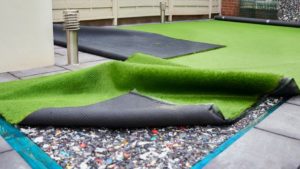
Pros: Artificial grass or synthetic turf achieves a high level of protection and shock absorption compared to natural grass. When installed with proper padding and infill, it becomes ADA compliant and meets ASTM standards. Plus, artificial grass looks natural and comes in various colors and styles. It has both a low lifetime cost and is highly durable.
Cons: A disadvantage to artificial grass is the need for additional padding or underlayment. It can also be very costly to install due to materials, essential ground preparation, irrigation needs, and professional installation requirements. Artificial grass also requires weekly maintenance to avoid dust, sand, and leaves.
6. Bonded Rubber Mulch
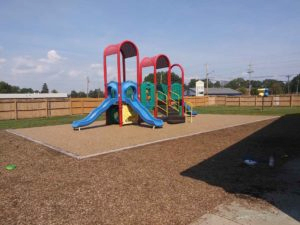
Pros: The unitary surface of bonded rubber mulch makes it relatively safe and accessible according to ASTM standards, protecting kids from a 10-foot fall if using 6 inches of materials. While its moderate cost can vary based on project scope, bonded rubber mulch is quick and easy to install for professionals. It is made from safe materials free of chemicals and is available in a variety of colors.
Cons: Pieces of the bonded rubber mulch can become loose or unbonded, creating safety issues and degrading the material. The material lasts ten years but requires intermittent patching and maintenance to meet safety guidelines and significant site preparation. Expect to go without stenciled games or designs if you opt for bonded rubber mulch.
7. Rubber Mulch
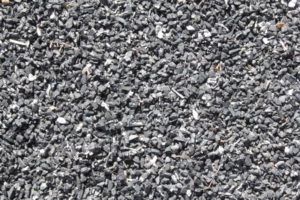
Pros: When you correctly install rubber mulch, you can meet acceptable ASTM safety standards. Rubber mulch is one of the safer playground surfaces. It gets extra points for its low-mid price range, ease of installation, and inability to decompose like natural wood mulch.
Cons: While rubber mulch is a safe surface, it can be difficult for those using a wheelchair or walker to get around. Rubber tire mulch requires frequent inspection. It’s easy for sharp objects, litter, or debris to get buried in the mulch. Plus, rubber mulch requires near-constant replenishment because it is easily washed away or kicked out from frequent activity.
8. Engineered Wood Fiber (EWF)
Pros: The popular surfacing option of engineered wood fiber mulch meets the basic accessibility standards of the ADA. In addition, if tested to ASTM F1292 standards, CPSC names it an appropriate surfacing type. EWF is cheap to install and doesn’t easily splinter like wood chips.
Cons: EWF may be popular, but it does have downsides. For children to safely land from a 10-foot fall, you’ll need a lot of it, a layer of EWF that is 9 inches deep, to be exact. While disabled people can move around on the surface, it’s not navigable with ease. EWF also requires significant maintenance, much like other loose-fill materials, as it wears away or gets kicked around.
9. Wood Chips

Pros: When it comes to loose-fill surfacing options, wood chips are visually pleasing and cheaper at $3 per square foot and have a degree of shock absorbency. According to ASTM, wood chips meet the critical fall height requirement. Safe landings can be made from 10 feet when using a 9-inch layer of wood chips.
Cons: CPSC calls wood chip mulch an inappropriate surfacing type. Plus, it doesn’t meet ADA requirements for surfaces. Much like other loose-fill materials, it requires much upkeep to prevent severe injuries and keep it looking nice. Watch out for hazards like glass, insects, mold, or splinters if you decide to use wood chips.
10. Poured Rubber Surfacing
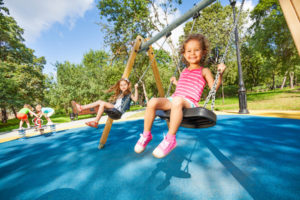
Pros: Want safe and accessible play for those with physical limitations? Poured rubber surfacing passes both ADA compliance and ASTM standards with flying colors. Made from natural materials and easily customized with color and designs, poured rubber surfacing is durable, soft, and can’t splinter. It can last up to 15 years with regular maintenance, coatings, or a new top layer in high-traffic areas.
Cons: In extremely dry or cold climates, poured rubber surfacing can become hard over time. Every few years, you’ll need to ensure you top it off with a fresh layer, which is a relatively simple process. In comparison, it’s not the cheapest playground surfacing option. However, the longevity of the material and its minimal maintenance create a low lifetime cost.
11. Rubber Tiles

Pros: If you’re planning an inclusive playground, rubber tiles are ADA compliant and meet ASTM standards. With rubber tiles, you’ll also enjoy low maintenance and low lifetime cost. Thanks to an interlocking system that creates smooth seams, you can easily swap old tiles and install new ones. Rubber tiles come in various colors and boast a porous surface, giving them excellent non-slip qualities in wet environments.
Cons: While the upfront costs are higher, in the long run, rubber tiles are a cheaper option when it comes to low maintenance, especially when you compare them to loose-fill surfacing options. Be sure to hire a professional with the right tools and experience to avoid unnecessary tripping hazards.
Choose The Right Playground Surfacing Material
Each playground project has its priorities, making the playground surface options unique to each project. However, now that you have a better understanding of all the playground surface options available, you can make an educated decision. Contact adventureTURF today for high-quality rubber surfacing material crafted to keep your playground safe, fun, and comfortable for everyone.
